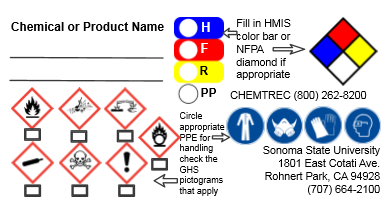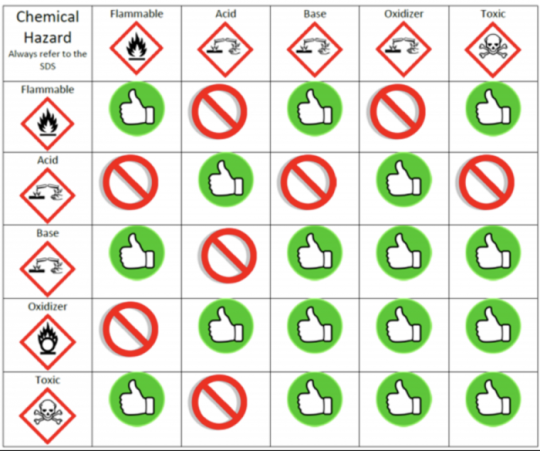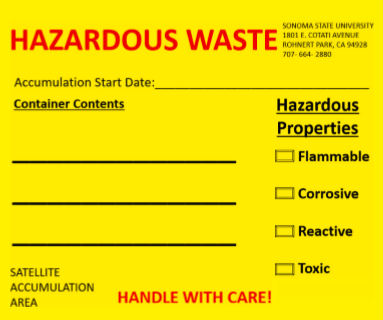Hazardous Materials Management
Page Content
The Sonoma State University Hazardous Materials Management Program establishes the requirements to be followed by University employees, students, and contractors who interact with hazardous materials (RCRA and non-RCRA) and universal wastes generated on campus. It is the policy of SSU that self-generated wastes will be handled, managed, transported, and disposed of in accordance with all applicable federal, state, and local regulations.
Simply defined, a hazardous material or waste has properties that make it dangerous or capable of having a harmful effect on human health or the environment. Hazardous materials and wastes must be stored in containers that are compatible with the material, and labeled with the material name and hazardous information. Labeling will be addressed in detail in subsequent sections.
How do I know if my material is hazardous?
Hazardous material or waste determination might come from an individual’s first-hand knowledge, a manufacturer’s label, or reviewing a Safety Data Sheet (SDS). Sonoma State University utilizes msdsonline.com as a primary database for SDS's. The vast majority of hazardous material found on campus can be referenced there. It is incumbent upon the department or employee to ensure that every SDS specific to materials in thier local inventory are available on MSDS Online. If you are working with a material that has a Safety Data Sheet and it is not available on MSDS Online, email a copy of the SDS to the Department of Environmental Health and Safety and they will upload the SDS to the MSDS Online catalogue.
You can use the QR code below to access MSDS Online as well.

The SDS library is periodically downloaded and maintained locally. If for some reason the system is inaccessible or there are connectivity issues, contact the Department of EH&S at [email protected] or (707) 664-2100 to request a hard copy.
Once a waste stream is determined to be hazardous, it cannot be disposed of in the trash or down a drain!
Safety Data Sheet Basics
Safety Data Sheets (formerly Material Safety Data Sheets, or MSDS) provide information on chemical products that help users of those chemicals handle them safely. They describe the hazards that the chemical presents, and give information on handling, storage, protective equipment, and emergency measures in case of an accident.
The SDS is an important information resource for employees and individuals handling hazardous materials on campus. It is important to read the SDS carefully and understand its contents before working with a hazardous chemical so that it can be safely stored, handled or used.
The information in a Safety Data Sheet is arranged under 16 headings to allow relevant information to be easily located; it is worth mentioning that older SDS do not necessarily have the same level of detail nor same format as the modern SDS. View this table for a brief explanation of the 16 sections of a modern Safety Data Sheet.
A commonly referenced item on the SDS are the hazard classification ratings, typically located in section 16. There are numerous hazard classification systems that are in use throughout the country, perhaps the two most common are the National Fire Protection Association (NFPA) 704 rating system and the Hazardous Material Identification System (HMIS). As both systems use a progressive scale of 1-4 in multiple categories, they are often mistaken with one another. View this Hazard Communication Guide to better understand the differences between the NFPA 704 ratings and the HMIS ratings.
How do I label secondary containers?
It is very common for a hazardous material to be transferred to a secondary container. Secondary containers must have the material name and all relevant hazard information as found on the original label. For example, if an individual transfers a cleaning solution from bulk packaging to a smaller spray bottle, the spray bottle is now a secondary container, and must be labeled in accordance with the original packaging. There are many ways to accomplish this. In some circumstances the manufacturers provide secondary labels. In some cases a label can be photocopied and taped in place. If necessary, the user can create a label that identifies the product and communicates the hazards associated with it. It is important to label as you go. If the container is too small for a label with all of the legal requirements (a common example is an eye-dropper with a chemical for a wet lab), then you must ensure that all of the secondary containers are consolidated in one storage container (such as a plastic tub or tray) which is labeled with all of the relevant hazard information.

This generic label for secondary containers is designed to use with an Avery 60505 sheet of labels. This label allows the user to select the appropriate hazards as they are identified on the original packaging, and cross out any that are not relevant. Direct any questions regarding secondary containers and labeling to the Department of Environmental Health and Safety at (707) 664-2100.
How should I segregate hazardous materials?
Hazardous materials must be segregated to minimize the possibility of an unintended reaction, which could result from a leak, earthquake, fire, or other unforeseen event. The first and best means of determining the incompatibility of a hazardous material is to review the SDS. Typically information on chemical segregation and reactivity is found in Section 7, Handling and Storage, or Section 10, Stability and Reactivity. If there is no specific guidance, this general guide to hazardous material segregation can be followed to minimize the risk of an unintended reaction:
Hazardous Material Compatibility Chart

When segregating incompatible materials, some basic steps should always be followed:
- Ensure that the material is being stored in a clean container with a screw-top cap that is closed and free from leakage.
- Ensure that the container is clean and properly labeled, with hazard information included.
- Store compatible materials in a cabinet designed and rated for the type of hazard associated with it, for example place flammable materials in a flammable materials storage locker.
- In the event that a standard (non-hazard rated) cabinet or shelf is being used for storage, place compatible materials in a plastic tray or tub that will hold 150% of the volume of the largest container being stored within it. For example, if the largest container in a tray is a one liter bottle of acetone, then the tray should be able to hold one and a half liters. This will allow safe handling if the largest container being stored fails and leaks all of its contents.
- Hazardous materials must never be stored on a shelf with no lip, or on the upper ledge of a sink. If your storage area doesn't have a lip to prevent leakage, then a plastic tray or tub must be used for hazardous material storage.
- Storage cabinets must be labeled with the general categories of the materials being stored within, i.e. "flammable" or "corrosive."
If you have any questions about chemical segregation, contact the Department of Environmental Health and Safety at (707) 664-2100.
What do I do with my hazardous waste?

Once a hazardous material is no longer going to be used for its intended purpose, it becomes a hazardous waste. This could be a hazardous material still in the originial packaging with a manufacturer's label that is simply no longer needed. It could be a hazardous material that has been captured from an experiment or industrial process (such as cleaning a spill) that is not intended to be used again. It could be a hazardous material that is spent, such as a lithium battery. Regardless of the origin, if it is hazardous waste, it must be labeled as waste and segregated (stored separately) from hazardous materials that are still in use. Hazardous waste must be labeled immediately. Labels must be accurate and fixed on hazardous waste containers or they cannot be removed from a location. Any individual or department can create their own label provided the required information is included.
Hazardous waste requires a label that says “Hazardous Waste” and contains the following information:
- Name and address of waste generator (School name and address).
- Name of hazardous waste, no chemical formulas or abbreviations.
- Physical state (liquid, solid, a contaminated medium such as clothing).
- Hazard characteristics (toxic, corrosive, flammable, reactive). GHS pictograms are the best way to express hazard characteristics, but verbiage is acceptable. This is the most commonly overlooked requirement.
- Accumulation start date: This is the date when the first drop of waste is added to the waste container. If the container is stored in a satellite accumulation area, the container must be collected by Environmental Health and Safety (EHS) and moved to the central accumulation area within 180 days. Once the container is stored in the central accumulation area, the container must be transported off campus by a designated disposal company within 90 days.
- You may use any label you wish as long as the legally required information is included. This easy to use label template can be printed on an Avery 5164 sized sheet of labels from any color printer.
- If you have numerous constituents you are capturing in one waste container (typically only lab waste is collected in this manner) you can use this large bottle label. Ensure all of the waste you collect is compatible! Contact the Department of Environmental Health and Safety at (707) 664-2100 with any questions.
Once a substance has been collected and identified as a hazardous waste, it cannot be stored with other hazardous chemicals. It must be stored in a designated waste cabinet or waste storage area. Ensure that you still adhere to segregation principals when storing hazardous waste.
Containers must be clean and free of external contamination, completely closed with a screw-top container while being stored, and the container must be compatible with the waste product. Food containers are never acceptable for storing chemicals. When combining compatible constituents in one container, ensure the label of the waste container reflects all constituents. It is important that labels are updated and accurate as waste is added to the container. Losing track of container contents can lead to “unknown” waste containers.
All unknowns must be analyzed and their hazardous contents identified. The cost to identify an unknown chemical can run several thousand dollars, and will be charged back to the department that generated the waste.
How does my hazardous waste get removed from campus?
By campus policy, hazardous wastes are collected from satellite accumulation areas every quarter. This process is facilitated by the Department of Environmental Health and Safety working directly with department representatives for waste collection. Once hazardous waste has been collected, it is stored in the central accumulation area and transported off campus by a licensed transportation company. EHS cannot accept responsibility for improperly labeled and/or improperly sealed waste containers and will not pick them up.
If your department has hazardous waste that you would like removed during the next quarterly disposal (lab pack), you can fill out this hazardous waste inventory sheet and email to the Department of Environmental Health and Safety. A representative will get back to you in a timely manner and schedule a transfer date.
Disposal of hazardous waste in the trash or down a drain is not allowed at any time. If you have any questions about waste characterization, segregation, packaging, and labeling contact Environmental Health and Safety at (707) 664-2100.
Educate yourself further by reviewing the Hazardous Waste Training Presentation.

